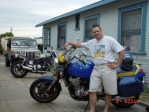
|
| Personal background |
|---|
Enlisted in the US Navy in 1986. It is an interesting job to say the least as there has been no two days that were the same. I am a steel worker, for those of you that are familure I am an HT1. I enjoy doing wood work and house renovations on the side for charity. For you terrorists remember this next passage and remember it well.
9 - 11
I will not forget
I will remember this day. I pledge to go to work as I always have in the past. The US NAVAL submarines I repair will be repaired with relentless effort, diligent attention to detail, with NO bolt left unturned. I will do my part to insure my shipmates can go out to sea, fight, and return home to their families knowing they did their part to squelch the madness of terrorism. Their daughters, sons, mothers, and fathers can live without fear of retribution for their way of life! |
| Thoughts about SETI and SETI@home |
|---|
| I believe space and time goes on for infinity. There was no beginning and there will be no end. So with this said it would be naive to think we are the only ones out here. I do not think we would be in any danger if we sent out a message.... after all we have been sending out radio for a while. Assuming that in 1902 Valdemar Poulsen's Arc wireless transmiter signals made it past Earth's ground influence; anyone out there that understood the pops and clicks and sent back a signal, we can only expect to hear a response from planets within 50 light years of us. The response would be 100 years old if we received a reply today. I have three computers crunching numbers for the SETI@home program in hope a true ET radio signal can be found. |
| Your feedback on this profile |
|---|
| Recommend this profile for User of the Day: |
I like this profile |
| Alert administrators to an offensive profile: |
I do not like this profile |
|
|

